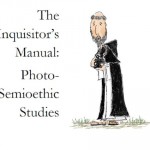2. The Camera as Significal Pedagogue: Selections from The Inquisitor’s Manual

I have walked about casually with a camera, taking pictures of whatever one comes across that seems worth recording, doing what Barbara Harrison (2002) calls “everyday photography” (97), viz, a kind of amateur photography that captures everyday life of generally ordinary people, even if there are occasional anomalies. This may sound like a simple task. In some sense it is. There is no thematic restriction. There is no need to look for a particular object of interest. One is free to roam about and collect whatever one encounters. However, fulfilling even a task like this employs some very complex processes, which may repay some reflection.
I am not thinking about how my eyes work, or how the camera’s technology is very advanced, which it is. I am referring instead to the thinking that occurs when we decide to take this picture, of this object, or of this event, or of this person… In each of these decisions, there is always the judgment that this is worth recording. And, in deciding that this is worth recording, one would have also decided to choose to take a picture of this, rather than that, or its surrounding objects. Even if one directs one’s focus on some other surrounding object, there are still other objects which one omits. In other words, there is always some kind of selection. One discriminates the possibilities for making a picture and realizes some and neglects others.
This kind of discriminating selection presupposes a judgment of what is valuable and what is not. Put in another way, the selection is not random, but evaluative. When one selects this rather than that to direct one’s focus, one employs normative judgments of ‘worth’. This does not necessarily mean that what one omits to make a picture something, one judges it to be unworthy of recording. However, when one does make a picture of some object, then that object is recorded as something worth recording to the photographer. There may be different reasons why different objects are worth recording, even to the same photographer. There may therefore be different interpretations of what it means to say that something is worth recording. Some one thing may be worth recording because it is ‘significant’, another could be worth recording because it is ‘beautiful’, and yet another can be worth recording because it is ‘shocking’. These various reasons constitute the evaluative guide that helps the photographer select what he considers worth photographing.
By examining the kinds of objects which the photographer brings into focus, one can infer the evaluative judgments that guided his photographic choices. For example, if he consistently picks out aesthetically pleasing patterns, we could say he had an eye for beautiful things, and that he possibly values beauty as a quality in things. This suggests that a casual photographic task can disclose to others as well as oneself what one’s normative criteria for identifying what is worth recording. Such a normative criterion may constitute aspects of one’s more sophisticated ideas about what else in other endeavors may be choice-worthy. For instance, what guides our picture taking could also feature in our moral deliberations about what is worth doing and pursuing. In short, there can be overlaps between the normative criteria that helps the photographer select objects to put into focus and the normative criteria that shapes the photographer’s ethical judgments in his other morally relevant choices.
However, casual photography is not just an opportunity for disclosing the ethically relevant ideas that guide one’s photography as well as those which may guide one’s moral life. Photography done casually places us in a mode of thinking that shapes some of these normative ideas. In this mode, our ideas about what really matters and what is valuable can change. This suggests to me that leisurely photography can be done to modify our value systems, and not merely to disclose them.
When using the camera in a leisurely manner, one is not collecting evidence to establish the truth of something. One is not for instance, doing scientific imaging, of which the primary purpose it is to discern the truth of something under investigation, using the photographic medium as a tool to achieve the discernment of the truth. In this latter case, one’s thinking constantly revolves around the question, ‘is this or that truly the case?’, or ‘what is the truth about which we are observing—what really happened, what could be a true description of that which has occurred?’ By comparison, when photographing without such an investigative agenda (even if one is making a record of something to remember, and therefore, collecting a token if the truth about it having occurred) the truth of the object is not really the primary issue. Here we must remember that I am talking about doing photography leisurely, and not for instance, with the clear purpose of documenting a historical event so that there could be little dispute of such an event having ever occurred. The fact that something is before the lens and an image is made of it is made more than sufficient proof of its truth, and that having been established, one’s thought about the picture proceeds onwards to its other and greater significances. For example, one takes a picture of a ‘graduation’, and having quickly collected some evidence of this, one’s thoughts no more linger on the reality of the event; instead one then quickly begins to focus on other meanings that judge the graduation as something worth recording: an ‘achievement’, ‘making family proud’, a ‘better future’… In photography done leisurely, our interest shifts quickly from the fact of something, to the value of, point of, the good of… that something.